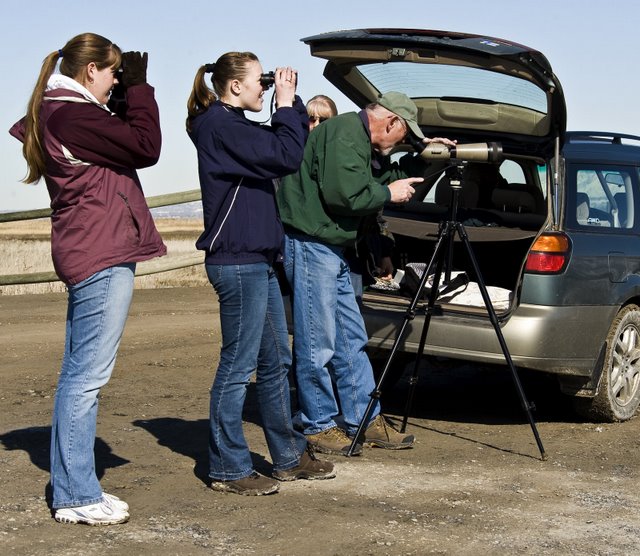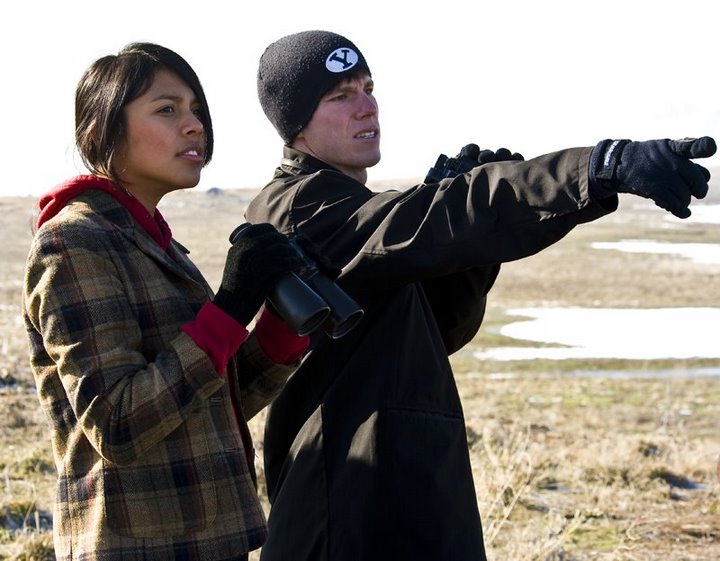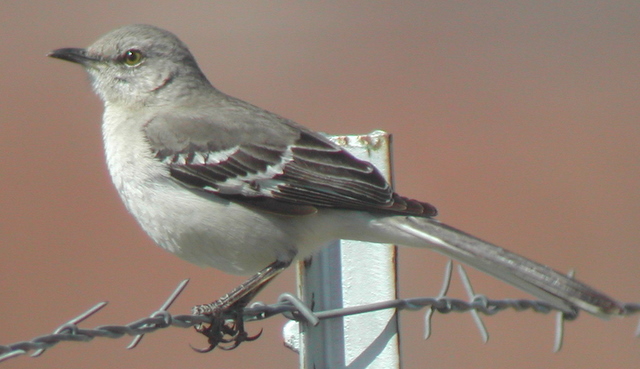Utah County Birders Newsletter
|
 |
Contents
March Meeting
Upcoming Field Trips
Ned's Notes
Bird of the Month
Field Trip Report - Farmington Bay
Backyard Bird of the Month
February Hotline Highlights
MARCH MEETING:
Thursday, March 12th.
“An Update on Birds of
Prey and Utah’s Mountain Plovers” by the world’s leading raptor
expert, Professor Clayton White, recently
retired faculty member from BYU.
Meet at 7:00 PM in the Bean Museum Auditorium on the BYU Campus.
April 25 2009: Fish Spring & Callao -
Day trip; leave Springville Walmart at 5:30 a.m.
May 14-18 2009: Great Salt Lake Bird Festival
- make your own arrangements.
June 5 & 6 2009: Brown’s Park National Wildlife
Refuge - looking for an opportunity to work on your Daggett county
bird list? Here’s the trip for you. Details TBA
We are actively recruiting people to lead local half-day field
trips, any time, any place. If you would like to lead a field trip or if you
have any ideas for this year’s field trips, please contact Lu Giddings at -
seldom74@xmission.com.
Ned’s Notes
By Ned Hill – President, Utah County Birders
“Enrich Your Birding Experience through Bird Sounds”
One morning in early May my wife and I were walking through our Provo foothills
neighborhood. Just a few houses down our street I heard a loud, ringing tone
coming from the hillside. After a brief silence—another ringing tone on a
different pitch. I knew that was not a sound usually heard in our neighborhood;
but I had heard it often in the wet forests of the Northwest. Without my
binoculars, I couldn’t locate the bird as it was against the sun in dense oak;
but the sound was diagnostic. Nevertheless, I put it on the Birdtalk and soon
interested birders came into the neighborhood and many were able to see their
first Varied Thrush, a Utah rarity.
While the public frequently refers to our avocation as “bird watching” we refer
to ourselves as “birders”. Why? Birding is so much more than simply watching
birds. We study them, feed them, go on strenuous adventures to find them, and
very often listen to them. In some cases, we even smell them (e.g., Hoatzin’s in
South America)! For anyone who knows bird vocalizations, birding takes on an
exciting added dimension. If you have ever birded with someone who is
experienced in bird sounds, you learn that you can find many more birds than you
otherwise could. One of my early experiences in Utah was birding with Merrill
Webb. As we hiked up a canyon in winter, Merrill said, “Hear that high-pitched
call? That’s a Townsend Solitaire. And those are Chukar’s chucking. And I hear
Horned Larks flying over…” all of this without seeing one of those birds—at
least at first.
Bird sounds are often important in differentiating closely related species.
Empidonax flycatchers, for example, look almost identical and some species can
only reliably be identified by sound.
How does one make sense of all those different bird sounds? While it can be
overwhelming initially, many birds are quite consistent in their calls and
songs. And, fortunately, people have recorded many of these sounds and made them
available on CDs (or even tapes). I started learning bird sounds by listening to
such tapes in my car as I drove to work or around town (much better than the
news). I played the songs of our more common birds and listened to them over and
over until they began to become familiar. One very helpful series of CD’s
(“Birding by Ear—Western”) groups birds by those that sound similar. The
commentator points out what differences to listen for. Other CD’s (including
those by our own Dr. Kevin Colver) have no commentary but include many of the
sounds from the more common field guides. You can also find recordings of birds
of other countries to help you prepare for birding adventures abroad.
Of course, one always has to be cautious about bird sounds. A few years ago I
was in the Anhuac NWR in Texas looking for rails in wet grasslands. We had just
found half a dozen Yellow Rails but we all hoped for a look at the very rare
Black Rail. As we returned to our cars, I heard the distinct call of a Black
Rail! But the habitat around the cars just wasn’t what one would expect for a
rail. As we all searched for the rail, we found perched in the top of a tree a
Northern Mockingbird, happily mimicking the call of a Black Rail! I still
haven’t seen one of those “mythical” birds.
To enrich your birding experience this year, why not challenge yourself to
learning the sounds of the birds around your neighborhood and then expanding to
birds that migrate into or through our state. You’ll be glad you did.
Field Trip Report
Farmington Bay - 21 February 2009
By Lu Giddings
 |
|
Brittany, Amy and Milt |
 |
|
Stephanie and Matt Photos by Lu Giddings |
Utah County birders visited Farmington Bay on Saturday February 21st. The
weather was warm, beautiful, and perfect for birding. While we managed to avoid
the large crowds one typically sees on February weekends, there were still
plenty of people traveling the muddy roads viewing the remaining eagles.
Northern Harriers were abundant, and Tundra Swans were seen in
substantial numbers. Perhaps the best bird of the day was a Glaucous Gull
seen at the south end of the road, in the company of numerous Herring and
Ring-billed Gulls.
Around noon we drove to Kaysville Ponds to enjoy the hooded mergansers and other
waterfowl. A Sharp-shinned Hawk prowling the area disturbed the
Great-tailed Grackles on the west side of the pond.
Trip participants were Bart Carter, Yvonne Carter, Brittany Gale, Lu Giddings,
Eric Huish, Amy Johnson, Kathy Knaus, Matt Mills, Milt Moody, Stephanie Nolasco,
Leena Rogers, Tuula Rose and Bonnie Williams.
A partial trip list: 38 species.
Canada Goose, Tundra Swan, Gadwall, American Wigeon, Mallard, Northern Shoveler,
Northern Pintail, Canvasback, Ring-necked Duck, Lesser Scaup, Bufflehead, Common
Goldeneye, Hooded Merganser, Common Merganser, Ruddy Duck, Pied-billed Grebe,
Great Blue Heron, Bald Eagle, Northern Harrier, Sharp-shinned Hawk, Red-tailed
Hawk, Rough-legged Hawk, American Kestrel, American Coot, Ring-billed Gull,
Glaucous Gull, Rock Pigeon, Northern Flicker, Black-billed Magpie, American
Crow, Common Raven, American Robin, European Starling, Song Sparrow, Red-winged
Blackbird, Western Meadowlark, Great-tailed Grackle, House Sparrow
 |
|
photo by Cheryl Peterson |
Bird of the Month
Northern Mockingbird
Mimus polyglottos
by Cheryl Peterson
I'm not sure why, but I get excited when I find at least one or two Northern
Mockingbirds in Utah County each year. For the past three years there has been a
pair of mockingbirds on Swede Lane that have stayed there
for the summer and into the fall. It is so enjoyable to watch their behavior,
listen to their calls and try to get a good photo.
Mockingbirds nest in low shrubs and trees, between 3 and 10 feet from the
ground. The nest is an open cup and
made of twigs and lined with grasses, rootlets and dead leaves.
The mockingbird's diet consists of fruits, crayfish, sowbugs, snails and small
vertebrates. It forages on the ground and from perches. Nestlings feed mostly on
insects and some fruit.
The Northern Mockingbird is famous (or infamous) for its song; thus its nickname
is the “American Nightingale.” It imitates many other birds and sounds. I smiled
when I read Ned's account of the mockingbird mimicking the Black Rail. Once when
I was birding at Lytle Ranch, I became too tired to drive back into St. George
to get a motel room. I pulled off the road and slept in my car that night.
I was awakened the next morning to what I thought was a Cactus Wren. I jumped
out of my car and discovered the “wren” was actually a mockingbird. I was only
slightly disappointed.
The mockingbird continues to learn new sounds throughout its life. The male
sings from February to early November. He sings through-out the day and into the
night, especially during a full moon. I was surprised to learn that the male has
two distinct repertoires of songs; one for spring and one for fall. The female
doesn't sing as loudly as the male and she sings mostly in the fall and rarely
during the summer.
February 2009
Bonnie Williams – Mapleton
Eurasian Collared-Dove on the last day of the month.
Milt Moody - Provo
Two Cedar Waxwings observing the Pine Siskin feeding frenzy.
Eric Huish - Pleasant Grove
Bushtit - A flock of 21. Yard lifer #92.
Reed Stone -Provo
Cassin's Finch at feeder.
Lynn Garner - Provo
A juvenile Sharp-Shinned Hawk taking his pick from the flock of Pine
Siskins at my feeders.
Cheryl Peterson – Provo
Pine Siskins (25+) were going to be my backyard bird of the month choice
until a Townsend's Solitaire showed up.
We would like you to share your favorite backyard bird each
month. Please send your favorite bird at the end of the month to
newsletter@utahbirds.org or call
Cheryl Peterson at 375-1914 (home) or 787-6492 (cell).